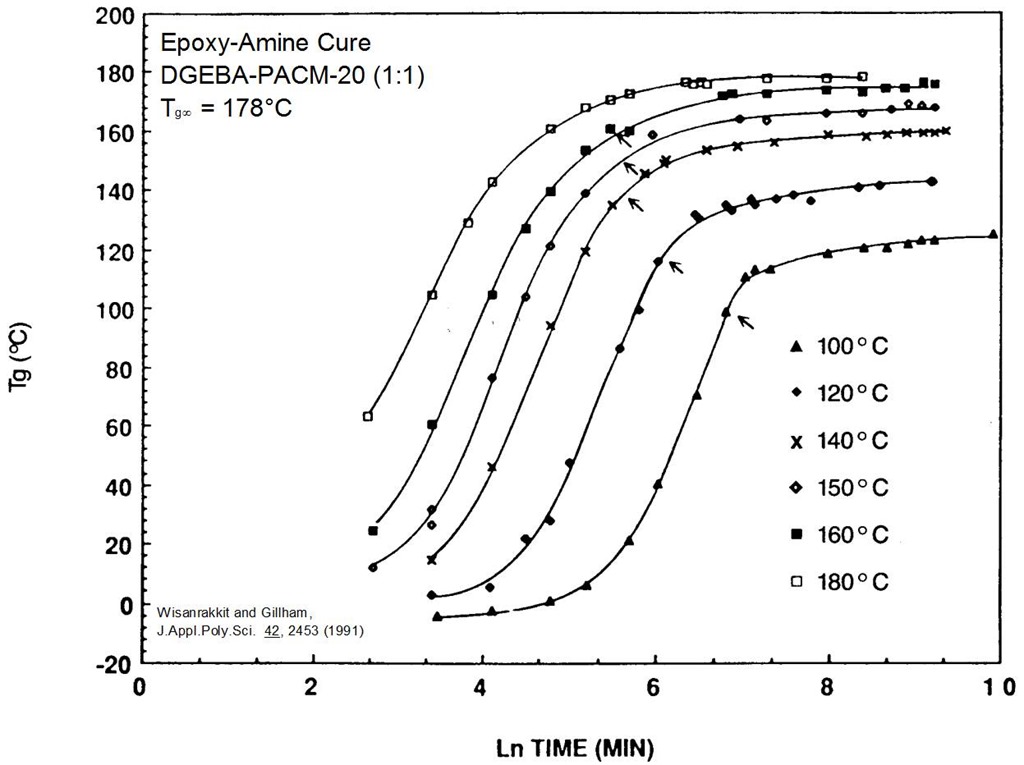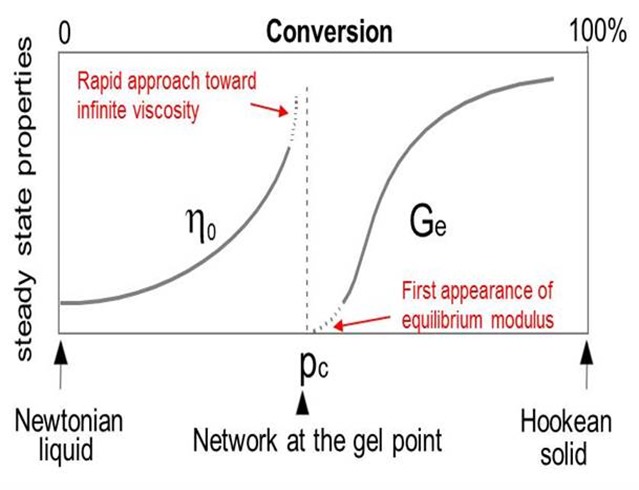 In some of our previous posts we discussed the concepts of gelation and vitrification during thermoset curing. In this series of posts we are going to give some practical examples of how gelation and vitrification impact thermoset curing. Thermosets are unique in that during processing a chemical reaction (curing) transforms small molecules into a large crosslinked network. The use of small molecules as starting materials allows for many types of processing such as adhesive dispense, composite fabrication, protective coating applications and more. Typical thermoset resins are epoxies, phenolics, unsaturated polyesters, vinyl esters, bismaleimides, and others. During curing low viscosity monomers and oligomers undergo a chemical reaction that changes the thermoset from a low viscosity liquid to a crosslinked solid.
In some of our previous posts we discussed the concepts of gelation and vitrification during thermoset curing. In this series of posts we are going to give some practical examples of how gelation and vitrification impact thermoset curing. Thermosets are unique in that during processing a chemical reaction (curing) transforms small molecules into a large crosslinked network. The use of small molecules as starting materials allows for many types of processing such as adhesive dispense, composite fabrication, protective coating applications and more. Typical thermoset resins are epoxies, phenolics, unsaturated polyesters, vinyl esters, bismaleimides, and others. During curing low viscosity monomers and oligomers undergo a chemical reaction that changes the thermoset from a low viscosity liquid to a crosslinked solid.
Gelation
Gelation is a defining characteristic of a thermoset and is controlled by the resin and hardener chemistry. Gelation is the incipient formation of a cross-linked network. A thermoset loses its ability to flow and is no longer processable above the gel point, and therefore gelation defines the upper limit of the work life.The gel point can be calculated if the stoichiometry of the resin and hardeners is known. (see https://polymerinnovationblog.com/thermoset-characterization-part-4-introduction-gelation/ ). In the figure above left, the curing reaction is represented schematically for a blend of difunctional and trifunctional reactants. Reaction in the early stages of cure {(a) to (b)} produces linear, chain extended and branched molecules and reduces the total number of molecules. Macroscopically the thermoset can be characterized by an increase in its viscosity h (see Fig. 1 below). As the reaction proceeds the increase in molecular weight accelerates and all the chains become linked together at the gel point into a network of infinite molecular weight {approximately (c) in the figure above left}. The gel point coincides with the first appearance of an equilibrium modulus as shown (which means it can support a load without flowing) in Fig. 1. Gelation does not affect the rate of cure and reaction continues beyond the gel point {(c) to (d) above left} to complete the network formation.
Figure 1. Changes in viscosity and modulus during typical thermoset curing (from reference 1)
Vitrification
The Merriam-Webster online dictionary defines vitrify as “to convert into glass or a glassy substance by heat and fusion.” In the case of thermosets, the definition is pretty close, since the glassy state can be obtained during cooling from the rubbery state and as we will see in this series of posts, vitrification can occur under the right conditions during curing. In thermoset curing, vitrifcation is the development of the glassy state as the curing reaction increases the Tg to the cure temperature. Vitrification occurs when temperature Tg = Tcure.
First, let’s provide some definitions of vitrification in the context of thermosetting polymers:
- Glass formation due to Tg increasing from below Tcure to above Tcure as a result of reaction
- Definition of vitrification: Tg = Tcure
- Only occurs when Tcure < fully cured Tg
- Reversible by heating: liquid or gel back to glass
- Dramatic slowing of rate of cure and the reaction becomes diffusion controlled
Let’s use Figure 2 to illustrate some key points regarding vitrification during thermoset curing.

Figure 2. Glass Transition Temperature (Tg) as a function of curing time at various cure temperatures (ref 2).
In Figure 2, the small arrows show were Tg = Tcure. A few characteristic features are clearly visible. The slopes of the Tg – Time curves are parallel in the early stages of curing. The overall shapes of the curves are also very similar. The key feature to note is that the rate of increase in the Tg slows dramatically after Tg = Tcure. The cure rate slowing is very obvious in the 100 and 120oC curves. As discussed above, the cure rate does not change as the chemical reaction passes through the gel point. This is not the case however with vitrification. As the Tg increases due to the chemical crosslinking, when the Tg exceeds the Tcure, the thermoset begins to transition into the glassy phase. Think of this as a glass transition temperature in reverse, driven by chemistry/crosslinking, not by a temperature change as observed in a typical Tg heating curve by DSC or DMA. For a more detailed description see https://polymerinnovationblog.com/thermoset-characterization-part-7-introduction-vitrification/.
In the next several posts we will give practical examples of how gelation and vitrification can impact thermoset processing.
References
- H. H. Winter, Polym. Eng. Sci. 27, 1698 (1987).
- Wisanrakkit and Gilham, J. Appl. Poly. Sci., 42, 2453 (1991)


Leave a Reply